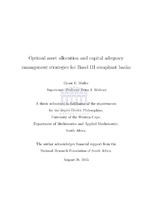| dc.description.abstract | In this thesis we study a range of related commercial banking problems in discrete and continuous time settings. The first problem is about a capital allocation strategy that optimizes the expected future value of a commercial bank’s total non-risk-weighted assets (TNRWAs) in terms of terminal time utility maximization. This entails finding optimal amounts of Total capital for investment in different bank assets. Based on the optimal capital allocation strategy derived for the first problem, we derive stochastic models for respectively the bank’s capital adequacy and liquidity ratios in the second and third problems. The Basel Committee on Banking Supervision (BCBS) introduced these ratios in an attempt to improve the regulation of the international banking industry in terms of capital adequacy and liquidity management. As a fourth problem we derive a multi-period deposit insurance pricing model which incorporates the optimal capital allocation strategy, the BCBS’ latest capital standard, capital forbearance and moral hazard. In the fifth and final problem we show how the values of LIBOR-in-arrears and vanilla interest rate swaps, typically used by commercial banks and other financial institutions to reduce risk, can be derived under a specialized version of the affine interest rate model originally considered by the bank in question. More specifically, in the first problem we assume that the bank invests its Total capital in a stochastic interest rate financial market consisting of three assets, viz., a treasury security, a marketable security and a loan. We assume that the interest rate in the market is described by an affine model, and that the value of the loan follows a jump-diffusion process. We wish to find the optimal capital allocation strategy that maximizes an expected logarithmic utility of the bank’s TNRWAs at a future date. Generally, analytical solutions to stochastic optimal control problems in the jump setting are very difficult to obtain. We propose an approximation method that exploits a similarity between the forms of the control problems of the jump-diffusion model and the diffusion model obtained by removing the jump. With the jump assumed sufficiently small, the analytical solution of the diffusion model then serves as a proxy to the solution of the control problem with the jump. In the second problem we construct models for the bank’s capital adequacy ratios in terms of the proxy. We present numerical simulations to characterize the behaviour of the capital adequacy ratios. Furthermore, in this chapter, we consider the approximate optimal capital allocation strategy subject to a constant Leverage Ratio, which is a specific non-risk-based capital adequacy ratio, at the minimum prescribed level. We derive a formula for the bank’s TNRWAs at constant (minimum) Leverage Ratio value and present numerical simulations based on the modified TNRWAs formula. In the third problem we model the bank’s liquidity ratios and we monitor the levels of the liquidity ratios under the proxy numerically. In the fourth problem we derive a multi-period deposit insurance pricing model, the latest capital standard a la Basel III, capital forbearance and moral hazard behaviour. The deposit insurance pricing method utilizes an asset value reset rule comparable to the typical practice of insolvency resolution by insuring agencies. We perform numerical computations with our model to study its implications. In the final problem, we specialize the affine interest rate model considered previously to the Cox-Ingersoll-Ross (CIR) interest rate dynamic. We consider fixed-for-floating interest rate swaps under the CIR model. We show how analytical expressions for the values of both a LIBOR-in-arrears swap and a vanilla swap can be derived using a Green’s function approach. We employ Monte Carlo simulation methods to compute the values of the swaps for different scenarios. We wish to make explicit the contributions of this project to the literature. A research article titled “An Optimal Portfolio and Capital Management Strategy for Basel III Compliant Commercial Banks” by Grant E. Muller and Peter J. Witbooi [1] has been published in an accredited scientific journal. In the aforementioned paper we solve an optimal capital allocation problem for diffusion banking models. We propose using the solution of the Brownian motions control problem of [1] as the proxy in problems two to four of this thesis. Furthermore, we wish to note that the methodology employed on the final problem of this study is actually from the paper [2] of Mallier and Alobaidi. In the paper [2] the authors did not present simulation studies to characterize their pricing models. We contribute a simulation study in which the values of the swaps are computed via Monte Carlo simulation methods. | en_US |

